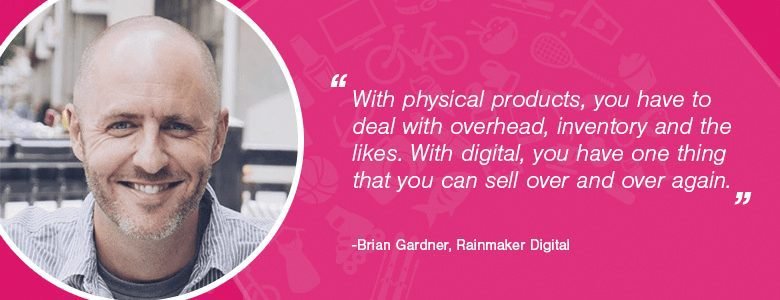Still wondering what digital product to sell and how to sell it?
I have been there. Since 2008, I have sold every type of product (digital, physical, SaaS, services) under the sun. I’ve tested a lot of markets, some failed and some didn’t.
I recently wrote about selling what physical products to sell online but digital goods could be your go-to.
They are tempting because they more simpler to run compared to physical products. You wouldn’t have to deal with the hassles of shipping and inventory.
However, just jumping into the wagon of selling downloadable products online without a concrete strategy can hamper your sales. Selling online is much more than just uploading your products on your website or online store and expecting buyers to troop in. Many people make this mistake of running in without an understanding of how it works.
Seeing this, I wrote this in-depth guide that’s designed to help you get a smooth ride.

Types of Digital Products To Sell
Digital commerce is a huge segment in itself. Since you’re probably not a movie producer or rap star, we’re going to leave out video and music. Our focus is on the popular paths for online entrepreneurs:
- ePublishing/eBooks – Selling information in digital books.
- Online Courses – Selling information in protected content.
- SaaS Products – Selling software products.
ePublishing/eBooks Market Growth
eBooks are the fastest growing digital product online. 2016 revenue is roughly $16 billion. Compound annual growth is projected to be around 16% between 2016 and 2020.
Overall growth during that time span is expected around 93% – making eBooks the biggest growth segment overall. Expected sales in 2020 is $29 billion.

Pros and cons of selling ebooks
You wouldn’t have to deal with inventory or shipping with eBooks. You can control your margins and set your own price. But you need to have some kind of expertise to make and sell eBooks; you can only write what you know.
Ebooks are super easy to plagiarize. Once someone has an ebook, they can load it up to the internet for anyone to read. Even if people buy, you can only sell an ebook once, vs a SaaS product.
Self-Paced E-Learning/Online Courses Market Growth
While the overall numbers for eLearning (corporate, universities) are massive, this report shows dismal growth in the self-paced eLearning market. In the US, sales of online courses actually decreased in 2015.
These figures include retail packaged content, custom content development services, and authoring tools/platforms.
Pros and cons of selling online courses
Your advantages in giving online courses are pretty much the same with the eBooks – no inventory and higher profit margin. On the other hand, you need expertise to teach something and getting this knowledge and experience could take time. It’s also slow to revenue and has a lower ceiling.
If you don’t have the desire to build a strong personal brand, selling info products like courses won’t work.
Software-as-a-Service (SaaS) Market Growth
The global SaaS market is estimated at around $261.15 billion in 2022 and is expected to grow to at the rate of compound 13.7% CAGR.

Pros and cons of selling SaaS
Like every other digital product, with SaaS, you don’t have to deal with inventory and shipping. Another good part is that you have a higher ceiling and a higher control over the price of your product. The downside is that it’s resource intensive. You’ll need to get different skills/people on board, and it takes a lot of time to generate revenue.
Selling Digital Products Vs Physical Products
There are benefits of selling digital products as against physical products and vice versa.
For digital downloads,you can get an unlimited warehouse on the internet. On the other hand, with physical products, you can easily demonstrate their value. The reason is that they are tangible so their purpose is easier to explain.
With the help of tools like MailerLite, you can fully automate the process of selling digital products online. Once set up, you don’t have to worry about warehouses, packaging, shipping, or any other costly factors associated with selling physical products.
The truth remains that whichever one you want to sell, as long as you chose the right products and use the right tactics, you can scale.
Experience goes a long way, which is why I asked 18 entrepreneurs the following question: what’s the single biggest advantage of selling digital vs physical products? I also want you to answer the flip side of that question.
Let’s take a look at first why you should sell digital over physical.
Why Sell Digital Products Over Physical
- High profit margin
- No shipping cost
- No shipping restrictions
- No storage space and cost
- No inventory shortage

Brian Dean runs Backlinko. He has experience selling both physical and digital products online. I highly recommend his flagship SEO course, SEO That Works.

Brian Gardner virtually created the premium WordPress theme market, with Genesis from StudioPress (what this site runs on). He’s a partner at Rainmaker Digital.

Brian is a Conversion Optimization Evangelist and spends a great deal of his time speaking and writing about conversion. Follow him on Twitter.

Skip McGrath provides advice and training to teach people how to sell on eBay and Amazon.

John Paul has a background in selling on Ebay. He helps entrepreneurs monetize their online presence. He also runs Brainy Marketer.

Henneke is the author of two 5-star rated books about writing and blogging, and she’s a regular contributor to popular marketing blogs like KISSmetrics and Copyblogger. Follow her on Twitter.
It’s also easy to test and manage customer service.

Thomas Oppong is the founder of Alltopstartups.com, a blog that offers ideas and resources for startups. He is the author of Don’t Start A Business, Solve A Problem. Follow him on Twitter.

Chris Garrett is an online business consultant, teacher, coach, new media industry commentator, writer (some might argue that point), speaker, and all-round web geek. Follow Chris On Twitter.

Tor helps online entrepreneurs NETWORK with influencers and position their BRAND so they can attract the right CLIENTS fast. Award-winning blogger. Follow him on Twitter.
Why Sell Physical Products Over Digital
- Faster to market, revenue
- Less time resources
- You get reorders
- Not so much competition
- Ideas can’t be easily copied
- It’s easier to demonstrate the value

Thomas co-founded FE International in 2010. He is passionate about entrepreneurship and online business. Connect with him on Twitter.

Nick is the CEO of ecomdash, inventory management software for ecommerce businesses. Follow ecomdash on Twitter.

Corey Ferreira helps entrepreneurs grow their business at Embolden. He’s a content marketer at Shopify and has experience selling digital products online. Follow him on Twitter.

Laurence O’Bryan helps authors sell books online at The Book Promoter. Follow him on Twitter.

Martin Zwilling is the founder and CEO of Startup Professionals, a company that provides products and services to startup founders and small business owners. Follow him on Twitter.

John Lincoln is CEO of Ignite Visibility, an avid blogger, entrepreneur and a digital marketing teacher at the University of California San Diego. Follow him on Twitter.

I know a few guys who launched a course and almost immediately it was posted online in several blackhat forums for people to access all the content for free.
Dave Schneider runs Self Made Businessman and is the Co-Founder of blogger outreach software Ninja Outreach. Learn how he built a 6 figure software business in a matter of months. Follow Dave on Twitter.
How To Sell Digital Products
You may have tried to sell digital products online and have failed. You are probably wondering ‘how to sell digital downloads’ and actually make it.

Pamela Hazelton is an ecommerce consultant, trainer and speaker. Connect with her on her LinkedIn Group or Twitter.
While it is true that for digital products, the instant delivery is a sweet spot, making actual sales extends beyond having a digital download to sell.
You need to understand first that on an average, customers take 6-7 interactions before they purchase your product. It could start from your squeeze page or even an affiliate website.
At whatever major touchpoint a random peruser interacts with your product, you’d have to strategically plan out how you meet them. One important touchpoint that you shouldn’t ever ignore is the live chat. It gives you the opportunity to convert fast.
If you want to successfully convert them, you’d have to follow these steps:
- Find and position product/market fit
- Tap into on-demand traffic
- Offer a lead magnet
- Offer a tripwire
- Bring in your core product
- Maximize customer lifetime value
- Marketing automation
Find and Position Product/Market Fit
80% of ecommerce startups fail and one reason for that is lack of product/market fit. You wouldn’t have to be part of that number if you ensure that your product fit the needs of the market.
Buyers don’t buy products, they buy outcomes. The promise of a feeling; I read your book, I am able to make $5000 dollars or feel this way. If you find product/market fit – you’ll be able to sell digital and physical products.

Kunle Campbell is a specialist e-commerce marketing consultant for mid-tier online retailers. Check out his blog, 2x eCommerce and his ecommerce course. Follow 2X Media On Twitter
If you are going to sell digital, the first thing you’ll need to do is find your product fit.
The best way to go about it is to look out for a product that’s in demand in a growing niche. You also need to ensure that you can compete with current sellers of that product and actually sell. I use Junglescout to look out for products and find out where my opportunity lies.
Once you get that down, you have found product/market fit. But it’s more than just finding it, you have to position yourself to potential customers that you have a product that fits their need.
That’s where your brand comes in. Your brand’s message should be clear on what your product gives to the user. That is the before and after. Before your product, I was frustrated with my lack of income, after your product, I know how to make money, I am motivated and happy.
You also have to know your customers. You can use a storyboard to do this. Map out a persona of your average customer and think about what they are in need of and how your product fits that need. This gives you an angle to work with.
Generating On Demand Traffic
If you’ve had your website/store for a while and already have SEO traffic, that’s great. If you just set up your online store, on the other hand, you’ll need to look at other sources besides SEO.
Don’t get me wrong, SEO is great but it takes time to kick in; it could be months before you finally get the number of people you need to view your products.
The best way to get on-demand traffic at the start-up stage is through:
- Social media ads – Facebook works great here due to the demographics.
- Influencer/blogger outreach
- Other online ads
You need to know though that when choosing which to work with, you have to choose the right audience.
You’ll determine this by asking yourself who your average customer is, what they care about, and social media platforms they frequent
As you get this down, also start working on SEO so that it kicks in along the way.
Offer a lead magnet
A lead magnet is an offering of value in exchange for your potential customer’s information. When ‘lead-magneting’, you are offering an immediate free value. Essentially, the goal is to get their email address as targeted leads.
A good example of a lead magnet is your email marketing list. No, you don’t just say ‘subscribe to my list’. Doing that will leave you high and dry.
You have to give them a free offer that leaves them eager and wanting more of what you have. If you are selling an online course, you could offer a very short ebook for free that would put them on the path to wanting your course.
Lead magnets are thoughtful and targeted.
Offer a Tripwire
Tripwires are offers that are given at a lower price. It includes giving them a discount or showing them a ‘best deal’.
Don’t think about how much is leaving your pocket right now. It’s more expensive to get a customer than retain one after all so you’re going to spend.
Jeff Bezos once said ‘your margin, my opportunity’. So if you are thinking of your margin first without getting buyers, you are only pushing your potential customers to competitors who are offering that trip wire.
A tripwire comes after your lead magnet. When you have acquired new leads using your free offer, you can now warm a sales relationship through the tripwire. The aim of a tripwire is to convert a maximum number of your leads into customers.
With your tripwire, you give an irresistible low-ticket offer as a taster to your main offering. You would see the value this brings as we go through to the next steps.
After new customers checkout, you can offer them a one-click upsell of your core product.
Bring In Your Core Product
Your subscribers have gotten a taste of your lead magnet and tripwire. You have built trust in them, it’s time to give them something more. This is where your core product comes in.
Your core product is your main offering. Although it sits at a higher price point than your tripwire, you don’t necessarily have to make a profit from them. I am not saying you wouldn’t, but you don’t have to.
This is the mistake most of your competitors are making – trying to make profits from their core offer, and you can leverage on this. I prefer to put it into acquiring more customers.
You are probably wondering if there is any point in the process where you make huge profit. We are getting to that.
Maximize Customer Lifetime Value
While most businesses are focused on the core offer, smart and insanely profitable businesses are creating funnels and increasing profit with value maximizers.
The goal here is to get more sales of your product or an immediate sale of your second product. Think of it as what you offer to immediately raise transaction value.
I like using one-click upsells and subscriptions/recurring billings. There’s also cross-sells.
An upsell is getting more for a lower price. It can be the same product or a different product that’s related to the product they bought. McDonald’s core product is the hamburgers, but their upsell is the fries and coke.
A cross-sell is offering a different product. The more related they are, the closer your chances of selling. If you’re selling an eBook for a business plan, your cross-sell could be a marketing ebook.
This is the holy grail of selling because they make revenue more predictable since they come in monthly/yearly subscriptions. A lot of businesses use it. Dollar Shave Club and Netflix are a good example of how to use recurring billings.
The good thing is that you can use more than one type, so think of what works best with your core product and offer it.
Scale Sales With Marketing Automation
The purpose of your marketing automation is to drive people through your sales funnel. Convert leads into customers and convert customers into repeat buyers.
Using email automation, you can notify your leads/customers of new lead magnets, tripwires, core offers, and cross up sells.
One mistake some businesses make is sending offers only. You have gotten these leads/customers, don’t lose them by being in their faces with sales content all the time. There should also be a mix of brand messaging in there.
Not having marketing automation is simply leaving money behind!
Best Products to Sell Online
eBooks
eBooks are dominating the digital ecommerce space. The reason is that they are simple to produce and even easier to distribute. You can self-publish easily these days (thanks to Kindle, Kobo, and other devices) and stats show that self-published books dominate in sci-fi, romance and mystery than traditionally published authors. The best types of eBooks to sell and make profit now include:
- Crafts: People are looking for ways to learn new skills with an inexpensive route. Craft eBooks are often bestsellers as a result. You can write on that skill you know, be it knit, crochet, or other kinds of craft.
- Fitness: Whether the book is about dieting, exercising, meditation, or a mix of any two or all three, fitness eBooks are one of the best to sell now.
- CookBooks: There is a wave that keeps flowing of living healthy, people are now more than ever motivated to learn new homemade recipes. Whether it’s a vegan cookbook or healthy alternatives to butter, get it out there.
- DIYs: These are bestsellers. DIY guide on making your own cleaning agents, or decorating your house. There are different things to write about.
- Money: How to save on car purchase, how to make $10,000 in a week from your home. Money is a hot topic.
- Fiction: Fiction still sells like crazy. The genres that sell more are romance, sci-fi and teen fiction.
Pro Tip – look at Amazon top-selling book categories and see if they match your niche interest. You can use Jungescout to see the highest performing books in your niche. That tells you people will pay for the info.
Photos and Art
On Shutterstock alone, there are over 70 million photos, vectors, and illustrations currently being sold to the large crowd of over 750,000 active users. There’s also Dreamstime, iStock, Shutterfly, and a host of many other popular ecommerce stores for photography sales.
The problem with these stock sites though is that they take between 20% – 60% of your profit. That’s a lot of cut. It’s better to sell on your website. Having a website helps you advertise and showcase your portfolio, and maximize profit. With platforms like Visual society and SmugMug, and plugins like Sell Media, you keep 100% of your money.
Besides these tools, you also need to protect your product images, especially if you sell photographs. You don’t want those stolen; you can use Imagely to place watermarks on them.
The best photographs that sell look genuine, most popular ones display an emotion (sadness, happiness), a concept (like wealth or success), traditional festivals, travel, technology, and leisure activities. Images that tell a historical story are also great alternatives. A recent phenomenon is people selling their feet pics online! Check out our guide for how to sell feet pics safely.
Online Courses
E-learning is growing with unprecedented momentum. I looked into the best selling courses and they are:
- Business management and entrepreneurship
- Learning design tools such as Adobe Photoshop and Illustrator
- Learning how to code (Software and web development)
- Social media marketing and search engine optimization
- Healthy living
Themes, Plugins and Graphics
With everyone trying to start their own business these days, people are paying a lot of cash for logos, web banners, and themes. Avada, the most popular theme of Themeforest has raked in over $26,000,000 in sales. That’s just one theme. Logos also have a good market. Other elements that sell well are patterns, wallpapers, and brushes.
Saas Products
People are looking for software solutions, it is therefore not surprising that Mailchimp and Asana are getting premium subscribers every day.
I don’t think there’s any best Saas software to create. As long as you are selling a solution to a popular need, establish your business right, and follow the how to sell steps, you’d be fine.
You can also take a look at the popular types of Saas that sell well right now:
- Email marketing applications
- Contact management
- Project management
- Online course-based learning memberships
- File storage
Documents and Templates
Informational pieces in form of industry reports, manuals, or guides, and resume or proposal templates are great documents to sell now. If you have done research on an industry, think about the value of packaging that research as a white paper. Graphics design templates are also great products to sell.
Printables
Printable are digital files that you sell to customers in ready to print format. Products that sell well here include:
- Art prints
- Lesson plans
- Gift tags
- Workbooks
If you are still unsure of what digital products to sell, you can reverse engineer your competitors’ funnels. Look for eBooks, courses, or checklists that they are promoting and sign up for them. With this, you’ll be able to see what they are selling backend. Either way, figuring out your niche becomes easier by analyzing your product fit.
Top Tools for Selling Digital Products
When selling online, you’ll need an ecommerce platform, research tools, marketing tools, analytic tools, Social media management tools and accounting tools. While there are so many ecommerce tools, for digital products, you’d only need a fraction.
Ecommerce Platform/Online Store
You can either sell on a platform like Amazon or integrate a cart to your website. There are also tools that help you send to different platforms from one space. To sell your items digitally, you need to accept payment and grant access to your content, app or digital download.
Top ecommerce platforms for general digital products are:
- SendOwl
- Easy Digital Downloads
- Gumroad
- Sellfy
- Pixpa
- E-Junkie
- Shopify digital downloads app
- WooCommerce
- PayPal
WordPress is a great platform for selling digital products. These platforms are used for more than one type of digital downloads. If you are looking for specialized platforms on the other hand, for ebooks, you can use:
Most authors prefer to use E-Junkie and Gumroad though.
For online courses, I use Kajabi for my membership site. Other good ones are:
Check out this post for a full list of the best online course platforms.
Marketing Tools
Ready to start selling digital downloads?
Selling digital downloads doesn’t have to be a struggle. Just remember to choose the right product, platforms, and marketing offers for your customers. Also, strategically invest; spend more to gain more.
It takes time and resources to generate substantial passive income, but it can be done.
Did I fail to mention something that you’d like to know more about? Tell me about it in the comments.









